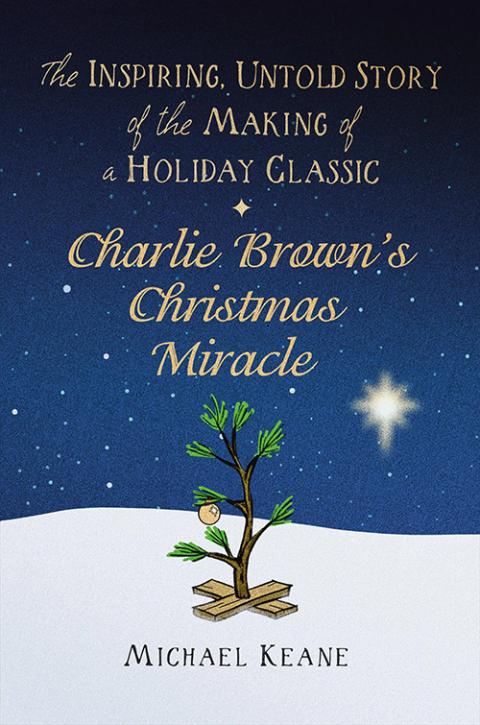
Unlike in most cartoons, the landscapes of "A Charlie Brown Christmas" are not just the setting. Along with the scrawny Christmas tree, the Earth is one of the most important characters. (Dreamstime/Kathy)
There is something profoundly "right" about "A Charlie Brown Christmas." The animated Christmas special casts a perfect tone in its music, in the simple innocence of the story, in its voices, and maybe most of all, in its silence.
In "A Charlie Brown Christmas," silence is not emptiness. It's an important part of the soundtrack, cushioning the soft piano notes of Vince Guaraldi's classic music, producing a meditative, almost trance-inducing liturgy. Moments of silence envelop the whining voices of the children in conflict, showing them to be but passing ripples on a much deeper presence.
The silence "speaks" in Linus' long walk off the stage after reciting the Christmas story, in the slight pause after Charlie Brown "kills" the tree, and most powerfully, when Charlie Brown sees the resurrected tree — a pause, a hop of surprise, another long pause — in TV time, the equivalent of Linus' speech.
Advertisement
Watching the movie for decades and writing about it for the last few years, only now it hits me: The silence is the voice of the Earth. And the Earth is the destination of the passion play.
Unlike in most cartoons, the landscapes of "A Charlie Brown Christmas" are not just the setting. Along with the scrawny Christmas tree, the Earth is one of the most important characters.
We meet the Earth in the opening scene: falling snow, bare trees and snow banks around the frozen pond. The Earth appears throughout, most notably at the end, when Charlie Brown dances down the road under the stars to the renewal of all the Peanuts around the resurrected tree.
Charlie Brown's discernment of his depression occurs outside, the Earth juxtaposed to the antagonist, commercialism. Other than the aluminum tree lot, the real effects of commercialism remain largely unseen in the show, like an evil spirit lurking in the shadows — open pit aluminum mines, toxic smoke and poisoned waters from factories, box store parking lots and landfills growing fat with the discarded wrapping paper and all-too-soon broken or unwanted gifts.
The relative absence of any portrayals of commercialism's ugly face heightens the power of Earth in the Christmas special. So does the fact that the Earth and sky are the most artistically complex. Michael Keane, in his book Charlie Brown's Christmas Miracle, explains how the Peanuts characters are so simple that animation posed significant challenges: How do you make them walk with such stubby legs? How do you make their large round heads turn?
In contrast, the landscapes are bold, dynamic, perhaps even more alive than the human characters. The artists channeled their talent into the landscapes, framing scenes that look like they "could be hung in a museum's exhibition of Impressionist art," says Keane.
Compare this to the flat, empty human spaces, such as the school auditorium. Notably, the conflict occurs indoors. The Peanuts are locked both inside and in inexplicable discord within a nondescript human made cavern, empty other than their own selfishness.
The tree appears in the one commercial setting and comes to the Peanuts in their indoor exile, is put on trial and takes upon itself their derision and brokenness.
After Linus recites the birth narrative from the Gospel of Luke, what Keane beautifully calls a "thunderbolt of clarity," Charlie Brown picks up the tree and walks outside. The rest of the Peanuts follow into the silence.
The tree leads the Peanuts back to the Earth, the communion of trees and dancing stars.
Is this some sort of intentional ecological message on the part of the film's creators, Charles M. Schultz, Bill Melendez and Lee Mendelson, like Schultz's insistence on including the Gospel passage? Not in the same way. While Schultz began infusing his comic strip with concepts from the growing environmental movement in the '70s, the arc of "A Charlie Brown Christmas" didn't emerge from an activism bent on policy outcomes. Rather, Earth as a character in "A Charlie Brown Christmas" flowed out of deep human and spiritual instincts.
Despite our tendency to modify the Earth for our own short-sighted ends — and often deface and destroy it — our romanticization of beautiful landscapes remains constant. They are a sign of health and flourishing, of life fully actualized. We yearn not to dominate, but to be part of a flourishing whole.
Our love of beautiful landscapes is not just representative of natural human settings, but also a prominent tenet of Christian faith. The Book of Revelation ends with the New Heaven and New Earth. The healing of humanity is integrally linked to the healing of creation.
I think this is explicitly linked with Christmas. Northern latitudes offer an added bonus: Every winter, the Earth is renewed. The healing power of winter is well-demonstrated by our cultural obsession with a white Christmas, even though only a small percentage of the U.S. typically has one. Snow covers the brokenness inflicted by humans, smooths over and rounds out the human-imposed angles, muffles the clanks and growls of our machine-driven culture, and weaves a mystical shroud of darkness with glinting ice and stars.
The Earth and sky remind us that they don't come from us, but we from them.
That is the conclusion of "A Charlie Brown Christmas." With the tree, the Peanuts are taken up into the heavens and merge with the land. Not erased, but transformed, and beautifully integrated into the Earth and sky.
With the tree, the Peanuts are taken up into the heavens and merge with the land. Not erased, but transformed, and beautifully integrated into the Earth and sky.
Schulz's "A Charlie Brown Christmas" isn't concerned with "fixing" the Earth. Its concern is fixing us. And it turns out that our fixing is dependent on returning to a right relationship with the Earth, not because of New Age eco-spirituality, but because of Christian instincts.
One of the many paradoxes is that in "A Charlie Brown Christmas," the Christian traditions that gave birth to the Christmas season are integrally connected with this return to the Earth, not in an overhanded dogmatic way, and not even through the subtle invitation that Schultz consistently wove into his art. Amazingly, "A Charlie Brown Christmas" does so by revealing the hidden drama with the Earth within what most of us do and feel every year, regardless of what we think it means.
Why is the holiday season so heartachingly beautiful and heartbreakingly melancholy at the same time? Why do we sacrifice living trees and bring them into our homes, gather round them as families and communities — a beautiful ceremony — yet drown ourselves in a flood of consumer goods and ideology?
There is enduring communal meaning at its heart, and its heart is in the Earth and in the spiritual mysteries that infuse and sustain her. Through Christmas, healing comes not only from a change of human hearts, but also a return to the heart of the world.
That is, after all, what the Incarnation is all about. And "A Charlie Brown Christmas," as well.








